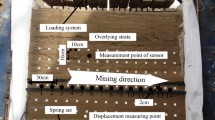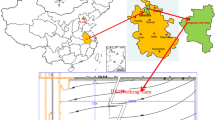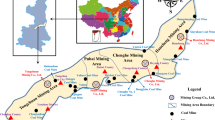Coal mine water outburst under fluid-solid coupling is a hot topic in coal geology. In this paper, the FLAC 3D simulation method is used to systematically study the water outburst problem of fluid coupling with coal mine floor. The results show that the vertical stress of the floor in the goaf has an obvious downward trend after coal seam excavation. Under the joint influence of mine pressure and bearing water pressure, the working face before the old roof pressure can be affected by two stages: the first stage is the advance pressure compression section on both sides of the working face, and the other stage is the pressure relief expansion section under the goaf. Before the old roof is pressed, the shear stress near the roof and floor is also affected to some extent. The front and rear displacement value of the goaf is negative, which is the result of the advance supporting pressure. The effective thickness of the floor waterproof layer decreases gradually with the advance of the working face. When the working face continues to advance, there will be a risk of water outburst. With the increasing width of the working face, the height of the guide belt increases. Therefore, in the process of mining activities, a variety of factors should be considered comprehensively, and a reasonable width of the working face should be selected to ensure the safety of mining.






Similar content being viewed by others
References
Feng, L., Li, J. (2002) Application of neurons with linear function in mine water quality classification. Coal Geology & Exploration. 14(4), 21-24.
Shi, L., Han, J., Song, Y. (1999) Prediction of water inrush in stope floor by probability index method. Journal of China University of Mining and Technology. 28(5), 442-460.
Wang, X., Li, W. (2017). Application analysis of controllable shock wave anti-reflection technology in Jining Coal Mine. Shanxi Coking Coal Science and Technology. 2, 4-7.
Zhang, Y., Qiu, A., Zhou, H. (2016). Research progress of electric explosion shock wave technology for fossil energy development. High Voltage Technology. 42(4), 1009-1017.
Hou, H., Wang, W., Zhu, X. (1997). Study of depositional model of Silurian system in Tazhong area, Tarim Basin. Acta Sedimentologica Sinica. 15(3), 41-47.
Colmenares, L., Zoback, M. (2009) A statistical evaluation of intact rock failure criteria constrained by polyaxial test data for five different rocks. International Journal of Rock Mechanics & Mining Sciences. 39, 695-729.
Du, Y., Aydin, A. (1993) The maximum distortional strain energy density criterion for shear fracture propagation with applications to the growth paths of E’chelon faults. Geophysical Research Letters. 20, 1091-1094.
Eyal, Y., Gross, M.R., Engelder, T., et al. (2001) Joint development during fluctuation of the regional stress field in southern Israel. Journal of Structural Geology. 23(2-3), 279-296.
Xu, J., Qian, M. (2004) Study and application of mining-induced fracture distr-ibution in green mining. Journal of China University of Mining and Technology. 33(2), 141-144.
Wang, Y., Jin, D., Zeng, Y., et al. (1998) Preliminary analysis of nonlinear characteristics of water inrush system from coal seam floor in karst mine. China Karst. 17(4), 331-341.
Wang, S., Elsworth, D., Liu, J. (2011). Permeability evolution in fractured coal: The roles of fracture geometry and water - content. International Journal of Coal Geology. 87, 13-25.
Zuo, Y., Li, S., Qin, S., et al. (2011) Understanding of the catastrophe theory analysis of water inrush mechanism of water-resisting floor break-and reply to the questions. Geotechnical Mechanics. 32(7), 2236-2239.
He, S., Wang, W., Shen, H. (2015) Factors influencing wellbore stability during underbalanced drilling of horizontal wells - When fluid seepage is considered. Journal of Natural Gas Science and Engineering. 23, 80-89.
Yang, H., Xue, X., Chen, X., et al. (2020) numerical simulation analysis of wellbore collapse and development environment damage considering the stress sensitivity of loose sandstone. Fresenius Environmental Bulletin. 29(12A), 11721-11729.
Yin, S., Wu, Z. (2020) Geomechanical simulation of low-order fracture of tight sandstone. Marine and Petroleum Geology. 100(7), 1-15.
Hu, Q. (2006). Research on new technologies to prevent coal mine gas disasters. Mining Safety and Environmental Protection. 33(5), 1-7, 89.
An, S., Chen, D., Zhang, Y. (2020). Application of controllable electric pulse wave anti-reflection technology in low permeability coal seam. Coal Geology and Prospecting. 48(4), 138-145.
Li, J. (2003) A Review of Techniques, Advances and Out-standing Issues in Numerical Modeling for Rock Mechanics and Rock Engineering, Imitational Journal of Rock Mechanics & Mining Sciences. 23(40), 283-353.
Kang, H., Zhang, X., Si, L. (2010) In-situ stress measurements and stress distribution characteristics in underground coal mines in China. Engineering Geology. 116, 333-345.
Li, L., Huang, B., Li, Y., et al. (2018) Multi-scale modeling of shale laminas and fracture networks in the Yanchang formation, Southern Ordos Basin, China. Engineering Geology. 243, 231-240.
Sahl, Y., Marwan, A., Abubakr M. I. (2022) Idriswater quality index and water quality standards for the assessment of groundwater quality in Great Kordufan States, Sudan. Fresenius Environmental Bulletin. 31(1), 157-165.
Jiang, R., Zhang, F., Cui, Y., et al. (2019) Production performance analysis of fractured vertical wells with SRV in triple media gas reservoirs using elliptical flow. Journal of Natural Gas Science and Engineering. 68, 1-15.
Shojaei, A., Taleghani, A., Li, A. (2014) A continuum damage failure model for hydraulic fracturing of porous rocks, International Journal of Plasticity. 59(8), 199-212.
Zhang, J., Liu, T. (1990) On the depth and distribution characteristics of mining-induced fracture zone in coal seam floor. Journal of China Coal Society. 12(2), 46-54.
Qian, M., Miao, X., Li, L. (1995) Theoretical study on fracture law of floor strata in stope. Chinese Journal of Geotechnical Engineering. 17(6), 56-61.
Zimmerman, R. (2000) Coupling in Poroelasticity and Thermoelasticity. International Journal of Rock Mechanics & Mining Sciences. 37(1), 79-87.
Salamon, M. (1984) Energy considerations in rock mechanics: fundamental results, J. South Afr. Inst. Min. Metall. 84, 233-246.
Zoback, M., Barton, C., Brudy, M. (2003) Determination of stress orientation and magnitude in deep wells. International Journal of Rock Mechanics and Mining Sciences. 40, 1049-1076.
Li, Z., Zhang, J. (1997) Crustal stress and hydrocarbon exploration and development. Beijing: Petroleum Industry Press. 138-140.
Long, J. (1982) Porous Equivalents for Networks of Discontinuous Fracture. Water Resources Research. 18(2), 645-658.
Acknowledgements
This study was supported by the Youth Science and Technology Talents Growth Project for Guizhou Education Department (Qian Education NO. [2018] 347th).
Author information
Authors and Affiliations
Corresponding author
Additional information
Translated from Khimiya i Tekhnologiya Topliv i Masel, No. 6, pp. 160–166, November – December, 2023.
Rights and permissions
Springer Nature or its licensor (e.g. a society or other partner) holds exclusive rights to this article under a publishing agreement with the author(s) or other rightsholder(s); author self-archiving of the accepted manuscript version of this article is solely governed by the terms of such publishing agreement and applicable law.
About this article
Cite this article
Song, C., Hu, X., Chen, Z. et al. Study on Stress – Fluid Coupling of Coal Seam Floor Water Outburst Based on FLAC 3D Simulation. Chem Technol Fuels Oils 59, 1304–1312 (2024). https://doi.org/10.1007/s10553-024-01648-3
Published:
Issue Date:
DOI: https://doi.org/10.1007/s10553-024-01648-3




